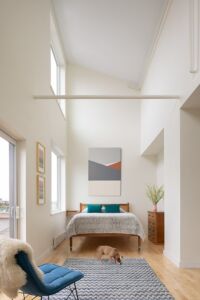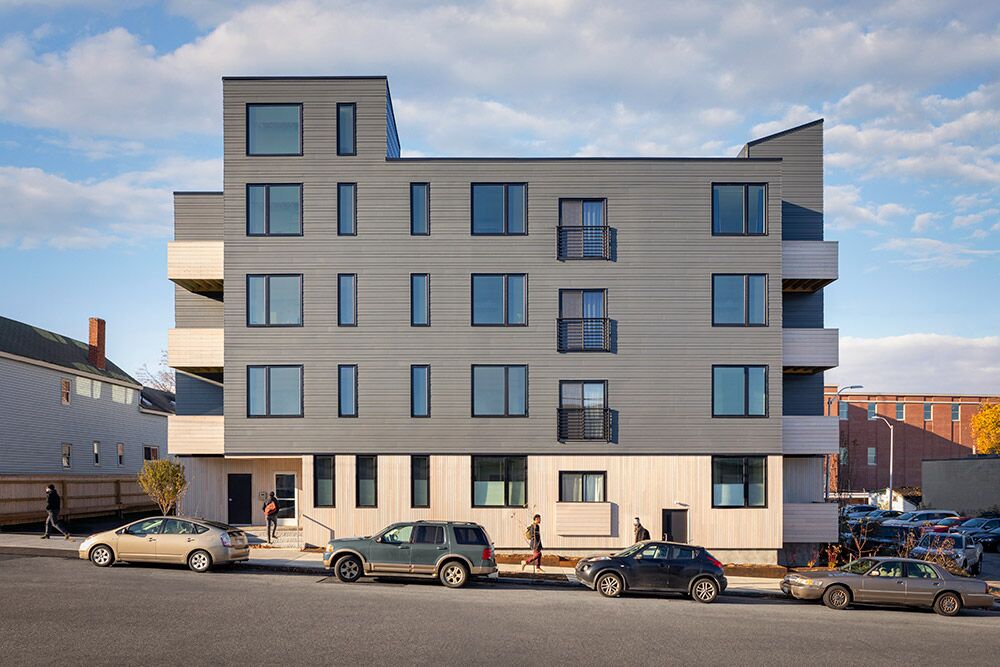Tap / click here for more than two dozen articles about the Gateway Code.
 To create affordable housing without government subsidies is not easy. Creating affordable home-ownership is even more difficult. “Missing Middle” housing is what’s been declared as sorely absent and hugely desired, all over the country.
To create affordable housing without government subsidies is not easy. Creating affordable home-ownership is even more difficult. “Missing Middle” housing is what’s been declared as sorely absent and hugely desired, all over the country.
For low-income apartments that are subsidized, we often see lower-quality construction. Designing these apartments to higher standards, with quality interiors, low energy use, long-lasting ecologically-oriented materials, and more is something of a trick.
So when I heard of an architectural firm that is designing successful non-subsidized affordable apartments as well as accessible homeowner units, I wanted to learn more.
Kaplan Thompson is in Portland, Maine. Their buildings are mostly in Maine, with sub-zero Winter temperatures, and yet they’ve figure out how to make their buildings have net-positive energy use. There’s more information about Kaplan Thompson and their other projects at their website, here.
Building costs are higher in California than in Maine, and I don’t care to get a whine-fest about how difficult and expensive construction is in Arcata. We can’t to a straight comparison with the costs of building a similar building locally. But here is an architectural firm that is making some headway in the creation of actual affordable housing.
We’ll look at two of their projects: Parris Terraces — an affordable non-subsidized building of studio-sized condominiums — and West End Apartments — a larger 5-story complex with 80% very-low-income apartments including transitional housing and on-site support services.
Both buildings were sited in areas that had previously been industrially-zoned. Both sites were seen as opportunities for housing to be built near to existing downtown and commercial destinations, thus potentially reducing local vehicle use.
For more on “Missing Middle” housing see Missing Middle Housing: A proven strategy for Affordability and Walkable Neighborhoods here on Arcata1.com, a 1-hour 26 minute video from the CivicWell group. Included is an audio that can be downloaded as a podcast, and an easily-readable table of contents of the key points.
Parris Terraces: Sound a bit like Gateway?
 The five-story Parris Terraces apartment design came out of a competitive design request-for-proposal by the city of Portland (Maine) to sell a city-owned property. Parris Terraces was a redevelopment of a city parking. “The goal was to bring people and businesses back to a neighborhood that had been home to industrial and municipal uses for decades.”
The five-story Parris Terraces apartment design came out of a competitive design request-for-proposal by the city of Portland (Maine) to sell a city-owned property. Parris Terraces was a redevelopment of a city parking. “The goal was to bring people and businesses back to a neighborhood that had been home to industrial and municipal uses for decades.”
Sound familiar the goal of the Gateway Area Plan here in Arcata?
To go on:
“Parris Terraces apartments are both attractive and affordable, seeking to create housing for an income bracket overlooked in the current market. Units can be purchased at Workforce Housing prices with no government subsidy and meet the desperate need for Missing Middle Housing. Upon opening, the building was fully occupied with 18 of the 23 homes going to first-time homebuyers at prices as low as $195k, a figure unheard of for downtown home ownership.”
“In order to fit 23 homes in a small footprint, the apartments are designed to be as efficient as possible. An open kitchen/living space allows for airiness in the common area, while a compact bedroom and bathroom leave extra room for closets and in-unit laundry. Tall ceilings – ranging from 9 to 14 feet – create the illusion of a larger space while elongated windows welcome abundant daylight. Six of the seven upper apartments also have a small balcony, providing a connection to the outdoors invaluable to urban living.”
“Sustainable design and Passive House techniques were applied to the structure as well. The project has a predicted overall energy use of 58% of a typical multi-family building (EUI of 22), even without renewable energy systems installed. We used local and carbon sequestering materials, avoiding high embodied carbon products as much as possible. The wood-framed building has densely-packed cellulose insulation and only a single piece of structural steel. All interior finishes are low-emitting and without toxins of concern. The heating and cooling systems – cold climate air source heat pumps – are completely fossil fuel free.”
What makes these Parris Terraces special
To be clear, I’m not saying this should be copied for Arcata. It is the design principles that we’re looking for.
Most of the Parris Terraces units are 400-500 square feet one-bedroom units. Kitchens are sleek – open shelving, granite counters, all-stainless appliances and a butcher block island. All units have outdoor access (either a deck or a Juliet balcony).
Eighteen condos were sold at $229,500 — and without the deed restriction that limits future re-sale prices. That is, the owners can build equity as prices for their units rises. Financing packages were pre-set, including a 100 percent financing for qualified buyers.
There are also three larger market-price units that feature lofts, and two “deed-restricted” condos (priced at $193,500 after a 10 percent down-payment grant offered by the city and developer). Included with the 23 units is a first-floor suite for guests.
Photos of Parris Terraces





For apartments with lofts. Note the narrow staggered-step ladder/stairway. These are also called “Witch’s staircases” — with half-treads that you must carefully ascend or descend, starting on the correct foot. The belief was that witches couldn’t climb them, so they were installed in many older residences in colonial New England. They also save space in the smaller houses of that period. These days they are generally not allowed by building codes except for access to lofts and other lightly-used spaces.


West End Apartments
West End Apartments, in Portland, Maine, consists of 116 apartments in two buildings in a walkable location, just blocks from the downtown area. The apartments include sizes from studios to three-bedroom units, with 80% very-low income-restricted and 20% market-rate units. Twenty-five of the 116 units are Americans with Disabilities Act (ADA) accessible — to “accommodate residents of all abilities.” There is a large community room, an outdoor plaza, on-site laundry, and an indoor bike storage. Street-level commercial non-residential spaces include a convenience store/restaurant and a community non-profit center.
The ranges of income for the subsidized units is $30,000 to $60,000 annual income.
The second phase of this property, West End II, is initially available as transitional housing for people who are experiencing homelessness. On-site resident-support services help residents achieve housing stability.
The project came out of residents and local organizations rallying together to create a better community in that location. The city was looking at a proposal to put a junkyard in the formerly-industrial location. This is an example of citizen engagement to bring positive improvements to housing and community needs.
The buildings are optimized for embodied carbon levels, low global-warming insulation, triple-glazed windows, potential for net-zero energy usage. The estimated energy usage (before net-zero) is 78% below the national average. The roofline’s geometry is a “solar mountain” angled optimally for the future installation of photovoltaic panels.
Photos of the West End Apartments
Again, we are not looking at the style or the regional aesthetics. (I personally do not care for the design.) We’re looking at the design principles, and what the architects were able to achieve.



Tap / click here for more than two dozen articles about the Gateway Code.


